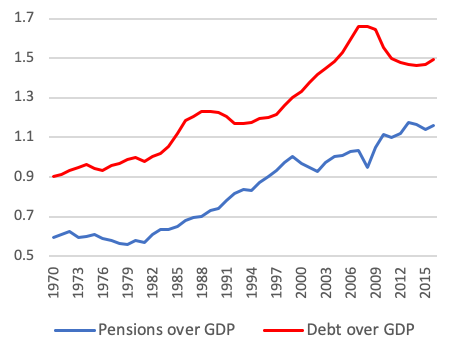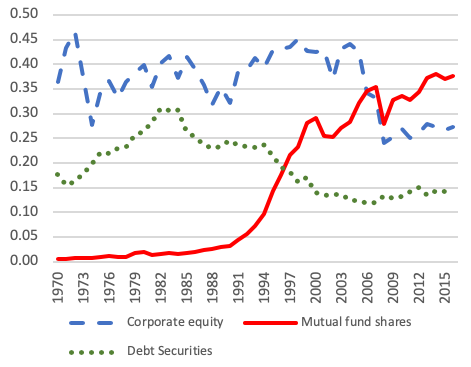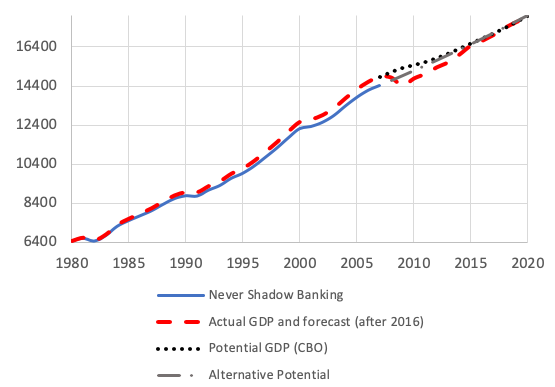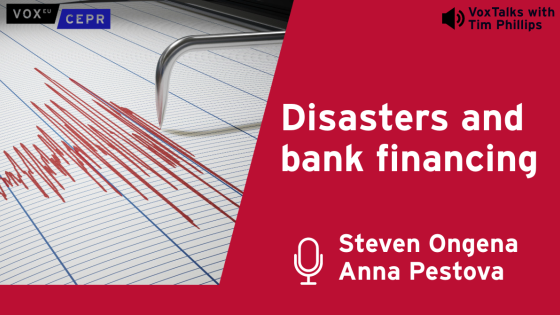Since Bernanke’s much-debated speech about the effects of a large external influx of savings to the US economy (Bernanke 2005), a great deal of attention has been given to the origins and impact of an international savings glut (e.g. Caballero and Krishnamurthy 2009). And although less acknowledged, the population in the US (as in many other developed economies) has also experienced a remarkable increase in life expectancy, which has translated into a larger demand for retirement savings and contributed to a domestic savings glut. While the global savings glut was deemed as one of the main drivers of the credit boom that ended in the Great Recession, what was the role of the domestic savings glut?
More savings do not necessarily mean more credit. If the number of savers (or the savings per saver) increase without a corresponding increase in investment opportunities, returns could fall enough to maintain total savings and leave credit unchanged. Thus, the arrival of new financial instruments can be helpful in facilitating savings but also in stimulating credit. As shown by Justiniano et al. (2017), the US credit boom seems to have been fuelled by the rise and expansion of securitisation and other novel financial instruments channelled through shadow banking – the financial sector that operates under the shadow of regulations.
The top panel of Figure 1 confirms to the naked eye that the massive increase in credit over GDP in the US, from 0.6 to 1.1 since the 1970s, mirrors in magnitude the increase of pensions over GDP, which correlates with the unprecedent increase in life expectancy conditional on retirement (from 77 years to around 83 years) that the US experienced in those three decades.
Figure 1 Pensions and credit in the US, 1970-2015
The bottom panel shows that shadow banking was critical in accommodating the large increase in pensions. While in the 1970s pension funds held 55% of their portfolios directly in corporate equity and debt securities, by the 2000s this figure declined to 40%, and it was more than compensated for by a large increase of mutual fund shares (from 0% to 35%). As most of these funds also invested in equity and debt, this can be interpreted as an indirect holding of similar financial instruments.
Shadow banking may have been more beneficial than harmful.
In a recent paper (Ordonez and Piguillem 2018), we show that:
- the domestic savings glut accounts for most of the credit boom;
- shadow banking was instrumental in accommodating the larger demand for insurance, and it did so by substantially decreasing the financial sector’s liquidity cost; and
- even if we assume that the Great Recession was entirely caused by shadow banking operations, the benefits prior to the crisis were of an order of magnitude larger than the cost of the crisis.
To study the macroeconomic implications of these demographic and financial developments, we proceed in four stages. The first stage is theoretical. We propose an overlapping generations model with heterogeneity in the bequest motives that allows for the coexistence of lenders and borrowers, as in Mehra et al. (2011). Individuals with high-bequest motives save for retirement by buying capital, partly borrowing from individuals with low-bequest motives, who save for retirement by depositing their funds with financial intermediaries. These financial intermediaries then fulfil two roles. One is to generate credit (lending for productive investments) and the other to generate safety (issuing deposits that are safe).
The cost of the first activity, which we denote the operation cost, is the cost of finding the best available investment opportunities, monitoring the management of projects, and administering payments. The cost of the second activity, which we denote the liquidity cost, is the cost of transforming long-term risky loans into short-term safe assets that can be liquidated at stable nominal conditions in relatively short periods of time in case a fraction of depositors larger than that expected to withdraw funds (those that are at their retirement age) choose to do so in advance.
Savers have access two types of intermediaries: traditional and shadow banks. Their difference is that shadow banks operate mostly via securitisation, which exhibit lower liquidity cost and can offer higher returns for deposits. However, depositing in shadow banks is also costlier because of searching needs, information asymmetries or fragility costs involved in their more opaque operations and lower regulatory constraints. For a given returns differential, as the life expectancy increases, so does the present value of the gains to ‘depositing’ in shadow banks – a higher life expectancy triggers an appetite for yields that can be fulfilled by shadow banks. The prosper of shadow banking is then an endogenous supply response to the higher demand of safe assets. While the latter forces a reduction in returns, the former compensates for it.
But how relevant were shadow banking operations in the US to the reduction of liquidity costs? To address this question, the second stage of our study is empirical. We show that the intermediation cost, measured by the spread between lending and deposit rates, declined from a stable level of 4% in 1980 to around 3% before the recent Global Crisis. We construct a measure of liquidity costs and show that the decline in intermediation costs can be explained almost completely by a decline in liquidity costs. This finding is consistent with those of Philippon (2015), who shows that operation costs have been constant for a century.
We then decompose the decline of liquidity costs and show that it can be mostly explained by the expansion of shadow banking. This is consistent with the properties of securitisation, which allow for the creation of assets that are backed by productive risky loans but are designed so that they can be liquidated with the same facility as government bonds and other unproductive assets, as in Gorton and Ordonez (2014). It is also consistent with shadow banking escaping blunt – and potentially restrictive –regulatory constraints that inefficiently impose investments in unproductive asset classes, as in Ordonez (2018).
But is the joint increase in life expectancy and decline in liquidity costs quantitatively consistent with the changes in volumes and prices of intermediation observed in the US since 1980? To answer this question the third stage is quantitative. We calibrate the economy to 1980 and show that the change of these two forces by 2007 can account for the observed evolution of households’ debt over GDP and total financial assets held in the economy. On the one hand, absent shadow banking, the change in life expectancy would not have been able to account for any increase in household debt over GDP, but just a steep decline in the risk-free rate. On the other hand, absent demographic changes, steady state output would have grown by only half the amount it did.
Figure 2 GDP evolution since 1980
Did the US win or lose from the operation of shadow banks? Even though in our study shadow banking is only beneficial, as we abstract from the possibility that it may collapse, we still shed light on this question in last counterfactual stage. We construct a hypothetical economy in which shadow banking never existed (and therefore there cannot be a crisis) and compare its GDP evolution with realised GDP in the US, in which shadow banking did exist. We find that, from 1980 to 2007, the existence of shadow banking generated additional production equivalent to 60% of 2007 GDP. This number can be put in context when compared to the cost of the Great Recession of an accumulated magnitude of 14% of 2007 GDP. Thus, even in the extreme case of blaming the crisis and its cost entirely on shadow banking activities, the economy still gained the equivalent of half of 2007 GDP from the operation of shadow banking.
Concluding remarks
Recent regulatory efforts have targeted restricting or eliminating securitisation in order to avoid future crises. By finding that the net gains of shadow banking may have dominated the costs of the recent crisis, our work highlights the importance of thinking about financial innovation in the context of structural changes in an economy, otherwise we risk asphyxiating novel financial products that may be fragile but provide benefits while in operation.
References
Bernanke, B (2005), “The Global Saving Glut and the U.S. Current Account Deficit” Sandridge Lecture, Virginia Association of Economists, March 10.
Caballero, R J, and A Krishnamurthy (2009), “Global Imbalances and Financial Fragility”, American Economic Review ,99, 584–88.
Gorton, G, and G Ordonez (2014), “Collateral Crises”, American Economic Review, 104 (2), 343–378.
Justiniano, A, G Primiceri, and A Tambalotti (2017), “Credit Supply and the Housing Boom”, Journal of Political Economy, forthcoming.
Mehra, R, F Piguillem, and E Prescott (2011), “Costly Financial Intermediation in Neoclassical Growth Theory”, Quantitative Economics 2 (1), 1–36.
Ordonez, G (2018), “Sustainable Shadow Banking”, American Economic Journal: Macroeconomics, 10, 33–56.
Ordonez, G, and F Piguillem (2018), “Retirement in the Shadow (Banking)”, CEPR Discussion Paper no. 13144.
Philippon, T (2015), “Has the US Finance Industry Become Less Efficient? On the Theory and Measurement of Financial Intermediation”, American Economic Review 105 (4), 1408–38.







